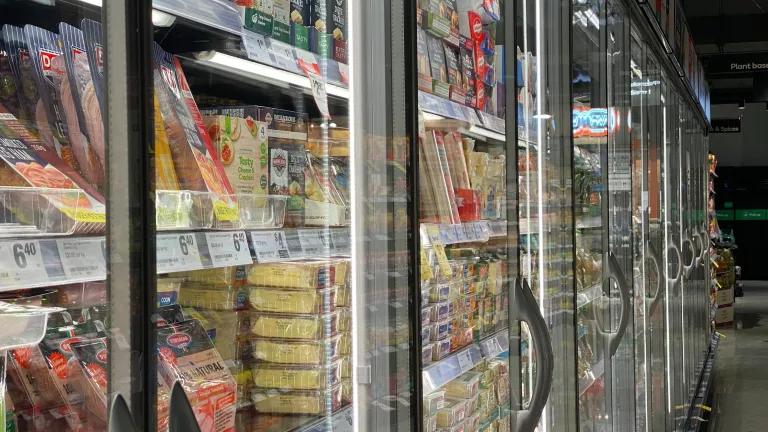EPA Takes Two Big Steps to Curb Climate-Warming HFCs
The new regulations will prevent up to a billion metric tons of harmful emissions.

The new regulations will prevent up to a billion metric tons of harmful emissions.
The U.S. Environmental Protection Agency (EPA) today released two regulations—one final, one proposed—aiming to curb the use and emissions of climate-warming hydrofluorocarbons (HFCs). Together, the rules will avoid HFC emissions equivalent to up to one billion metric tons of carbon dioxide (CO2) cumulatively through 2050, or as much as 10 coal-fired power plants would emit during that time.
Pound for pound, HFCs warm the climate hundreds to thousands of times more than carbon dioxide. They are used in your home as aerosol propellants and as refrigerants in air conditioners, refrigerators, and heat pumps. And they are used to cool motor vehicles, supermarkets, office buildings, and industries.
Both EPA rules are key pieces of implementing the American Innovation and Manufacturing (AIM) Act, the climate law enacted in 2020 to cut the supply of HFCs by 85 percent over 15 years, transition products and services to safer alternatives, and curb leaks and increase reuse of existing HFCs.
Technology transitions
The final rule released today, called a “technology transitions” rule under the AIM Act, sets dates by which industry must build products—such as aerosols, heat pumps, supermarkets, motor vehicles, and more—using climate-friendlier alternatives to HFCs. According to the new rule, these transitions must generally happen by 2025, 2026, or 2027, depending on the sector.
This regulation helps reduce demand for HFCs to keep pace with reductions in HFC supply, as prescribed by the AIM Act. It gives clarity to manufacturers and consumers as to what alternatives should be expected, and by when. These transitions will avoid HFC emissions of up to 876 million metric tons of CO2 equivalent (MMTCO2e) cumulatively through 2050 (in a high additionality modeling scenario), beyond what is being saved by implementing the AIM Act’s HFC supply phasedown.
For example, starting in 2025, air conditioners and heat pumps will be required to use climate-friendlier refrigerants with a global warming potential (GWP) under 700. The heating, ventilation, and air conditioning (HVAC) industry is prepared to comply with these long-overdue regulations by using refrigerants such as R-32 (which has a GWP of 675). These units will be more energy efficient than the outgoing models and significantly better for the climate, a key benefit as we press to roll out heat pumps across the country.
Similarly, starting in 2027, most new-construction supermarkets will be required to use refrigerants with GWP less than 150, an important step to reducing the climate impact of what is, today, a sector with a very large climate impact from its refrigerant emissions. In many cases, this will mean building supermarkets that use carbon dioxide itself. Although it’s the original greenhouse gas, carbon dioxide is an excellent refrigerant for those systems that keep our groceries cold and does not significantly contribute to climate change in the quantities used. Carbon dioxide–based supermarkets have begun to roll out across the United States, Europe, and more.
In some cases, the EPA’s new regulation will require states to update building codes to permit the use of climate-friendlier refrigerant alternatives, such as those that are forthcoming for air-conditioning and heat pump products. Today’s regulation signals in no uncertain terms that it’s now time to act on code changes.
Refrigerant management
The proposed regulation coming out of the EPA today—called “refrigerant management” under the AIM Act—sets leak repair requirements for many systems that use HFCs, promotes the use of “reclaimed” refrigerants, and more. This critical regulation aims to bring down emissions from the installed base of HFC-containing equipment and is projected to save 142 MMTCO2e cumulatively through 2050.
Life cycle refrigerant management is a core part of moving away from HFCs. As supply falls under the production and import phasedown, and demand falls as technology transitions occur, recovering and reclaiming HFCs has the potential to supercharge the process. Reusing old HFCs has the effect of (1) boosting the supply of HFCs without having to make any virgin gas, while capping leaks, and (2) reducing the demand for HFCs further by decreasing the amount needed to fill up leaky existing systems. The EPA’s new proposal goes a good way toward achieving those goals, but much more could be done under a comprehensive program, such as what we outline in this report.
The EPA has proposed capping the acceptable leak rate of HFC systems at between 10 and 30 percent per year, depending on the sector, and is proposing significantly expanding the universe of systems that must comply. The largest systems, those with more than 1,500 pounds of refrigerant, will also be required to use special technology called automatic leak detection.
In addition, under the proposed rule, any HFCs used in new supermarket systems, refrigerated transportation vehicles, and more must use reclaimed refrigerant. This type of approach will dramatically bolster demand for reclaimed HFCs—helping to improve the economics of refrigerant recycling—while further pushing companies to transition away from HFCs altogether.
HFC containers will also be subject to new tracking rules and any disposable refrigerant cylinders will need to be sent to reclaimers for proper evacuation before recycling or disposal. Many countries have banned disposable cylinders outright because they often release HFCs upon disposal, but the EPA has stopped short of doing so here. We will be paying close attention to see how this approach works.
In total, the EPA continues a full-court press to transition our economy away from HFCs. This is good for our climate and good for businesses that have invented and applied climate-friendlier alternatives. Once both rules are finalized, we’ll be that much closer to an expedited HFC phasedown that will usher in a new era of more sustainable heating and cooling for all.




